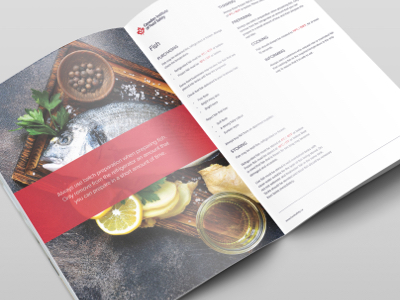.jpg?width=820&height=462&name=Adobe%20Express%20-%20file%20(73).jpg)
Fish and seafood are popular menu items across Canada - but they also pose serious food safety risks if mishandled. From live tanks to frozen fillets, fish must be carefully inspected, stored, prepared and cooked to prevent contamination and maintain quality.
Understanding safe fish handling procedures is vital for food businesses that serve or sell fish. These procedures help reduce the risk of food-borne illness and ensure you meet provincial and federal safety standards.
Why safe food handling procedures are essential
Fish can spoil quickly if not handled correctly. This not only affects flavour and texture but also increases the risk of bacterial growth and food-borne illness. Spoiled fish may carry pathogens such as Listeria monocytogenes, Vibrio or Clostridium botulinum, especially when consumed raw or undercooked.
Safe food handling procedures help ensure:
- Regulatory compliance with Canadian food safety laws
- Protection from liability
- Confidence and trust from customers
Whether you are working in a grocery store, sushi bar, seafood restaurant or hotel kitchen, these procedures are non-negotiable.
What to look for when purchasing fish
Fish can be delivered in three forms: live, refrigerated or frozen. Regardless of the form, food workers must always inspect deliveries immediately and ensure temperatures are correct.
Acceptable delivery temperatures:
- Refrigerated fish: 4°C / 40°F or below
- Frozen fish: -18°C / 0°F or below
Signs of safe, high-quality fish:
- Firm flesh that springs back when touched
- Bright, shiny skin
- Clear, bright eyes
Reject fish if you notice:
- Soft or mushy flesh
- Strong, unpleasant or "fishy" odours
- Sunken, dull or cloudy eyes
Only buy from approved suppliers that maintain a reliable cold chain and follow all relevant health and safety regulations.
How to store fish safely in your kitchen
Fish may be stored live, refrigerated or frozen - each with its own handling protocols:
Refrigerated and frozen fish storage:
- Store refrigerated fish at or below 4°C / 40°F
- Store frozen fish at or below -18°C / 0°F
- Avoid storing fish for extended periods; over time, frozen fish can become damaged or lose quality
Live fish storage:
- Use clean, well-maintained tanks specific to the fish species (freshwater or saltwater)
- Never mix freshwater and saltwater fish in the same tank
- Ensure proper aeration
- Remove dead fish immediately to avoid contamination
Proper storage is a fundamental part of your safe food handling procedures and should be enforced consistently across shifts.
Safe thawing practices for frozen fish
Thawing fish improperly is a key risk factor in many food-borne illness outbreaks and is easily avoided by following the simple procedures outlined below.
Thaw fish at or below 4°C / 40°F to prevent bacterial growth. The only recommended method for thawing fish is in the refrigerator.
Never thaw at room temperature or under warm water as this can cause rapid bacterial growth. Ensure the frozen fish is placed in a container, or a covered plate, to prevent risk of cross-contamination from drips during the thawing process.
You should only remove the exact amount of fish you need from the freezer - do not refreeze once thawed.
Preparing and cooking fish safely
When preparing fish:
- Use batch prep to limit the time fish spends out of refrigeration
- Only take out what can be prepped quickly
- Always clean and sanitize preparation areas, cutting boards and knives before and after use
When cooking fish, you must follow temperature guidelines to destroy harmful bacteria. The minimum safe internal temperature for fish is 70°C / 158°F or above (for at least 15 seconds).
Use a probe thermometer to check the internal temperature, especially for thick fillets or whole fish.
Informing customers about raw or undercooked fish
Some dishes - such as sushi or ceviche - may involve raw or lightly treated fish. While these dishes are common and often enjoyed, they carry added risk.
As part of your food safety procedures, always inform customers that:
“Cooking fish to the proper internal temperature is the only way to ensure that it is safe to eat.”
Transparency is essential. This step protects your customers and helps mitigate risk to your business.
Helping your team handle fish with care and confidence
Fish is a high-risk food, but with safe food handling procedures in place, it can be served safely. By following the guidelines above and investing in proper training, food businesses can reduce risk, meet regulatory requirements and build customer trust.
The Food Handler Certification Course from the Canadian Institute of Food Safety supports your team with practical knowledge to manage fish and other high-risk foods safely and confidently.
Sign Up
To receive notifications about our upcoming WHMIS training programs, complete the form below and our team will reach out to you with more information as soon as it's available.





